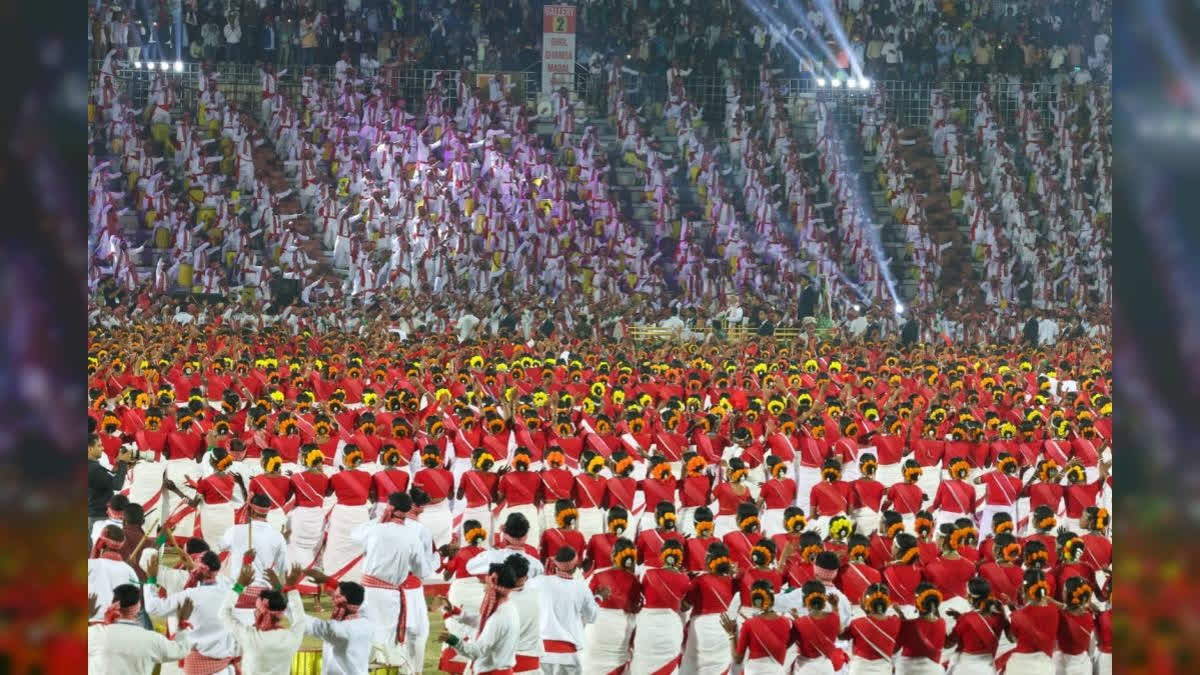By Manik Kumar Ray
Guwahati: "Jhumoir is our ancestral heritage, and this time, Jhumoir will be established in the world forum. I told my two daughters to abstain from their exams because I feared they would be deprived of participating in this historic moment of the Jhumoir grand event. The girls are young, so they can take the exams next year. We prioritiSe Jhumoir, not exams."
This was the comment of a parent from Titabar Basabari Tea Estate in Jorhat district, Assam who prevented their two daughters from appearing for the Higher Secondary examination out of fear that they would miss the mega Jhumoir dance event held in the presence of Prime Minister Narendra Modi on Monday evening. The two students, studying at Sri Sri Kamalabari Higher Secondary School, were kept away from the exams by their family. The Mega Jhumoir event was organised on the occasion of 200 years of the tea industry of Assam, and also 200 years of industrialisation in Assam.
"One bud, two leaves" – this is a living story associated with the two-hundred-year history of Assam's green tea leaves. The Jhumoir folk dance and song is the lifeline story of millions of people working in the tea gardens of Assam. It's not just the rhythm of Jhumoir or the beat of the Madal (a traditional instrument of the tea community people of Assam). It's a treasure chest carrying the two-century-old history of sorrow, pain, exploitation, and deprivation of a vast community.
On Monday, with a grand performance, Assam's 'Jhumoir dance' unofficially created history. Over 8,000 dancers performed the Jhumoir dance together in one place. Two hundred years ago, they were brought to Assam from various states of the country, under the pretence of good work, to work in the tea gardens. They became known in Assam as the Tea Community. Through two hundred years of assimilation, the tea community has become an important part of Assam's socio-political and cultural life. Currently, out of Assam's approximately 34 million population, the tea community numbers over 6.9 million. Of these, 4.6 million live in over 800 tea gardens. Today, Assam produces more than half of the country's total tea.
It is 7.30 pm, Monday, 24 February, 2025. Over 8,000 Artists Perform 'Jhumoir Dance': Millions of people in Assam were waiting for this historic moment when Jhumoir dance was illuminated in the presence of Prime Minister Narendra Modi. On Monday evening, at the Sarusajai Stadium in Guwahati, over 8,000 Jhumoir artists, including women and men dancers, along with musicians, performed one of the main folk cultures of the tea community of Assam, "Jhumoir Dance" in the presence of Prime Minister Narendra Modi, several central ministers, ambassadors from 60 countries, and many other dignitaries. Organised by the Assam government, this mega Jhumoir dance titled "Jhumoir Binondini" created history on Monday evening. PM Modi greeted the artists by riding in a special vehicle into the middle of the stadium in Guwahati.
Enthusiastic Tea Community Members: Jhumoir folk dance is an integral part of Assam's tea gardens and Adivasi society. Jhumoir has its own unique characteristics. The culture of the tea community, formed around the tea gardens, is colourful. The entire community, along with the people of Assam, were happy and excited about this event. However, this community also has a history of pain and suffering. This community, which has faced exploitation and deprivation for centuries, is still very backward and burdened with various problems.
However, the grand Jhumoir event has particularly encouraged the community. Artists from 800 tea gardens across Assam participated in this "Jhumoir Binondini" mega event. The Assam government also arranged for the mega event to be shown on large monitors in these 800 tea gardens. Assam Chief Minister Himanta Biswa Sarma announced ₹25,000 for each artist participating in Jhumoir Binondini. Meanwhile, for the mega Jhumoir dance event and the second edition of Advantage Assam, to be held on February 25th and 26th, domestic and foreign dignitaries have been flowing into Assam. Led by Union External Affairs Minister S. Jaishankar, ambassadors from 60 countries have arrived. On Monday evening, at 7.30 PM, the Sarusajai Stadium resonated with "Jhumoir Dance."
The Tea Community, Rich in Culture: Jhumoir, the beloved dance of the tea community, has its own unique characteristics. The tea community, formed around the tea gardens, is glorious with its unique art and culture. The tea community is known as the Tea Community only in Assam. In the 18th century, labourers from various castes, sub-castes, and clans, known as Adivasis in Andhra Pradesh, Madhya Pradesh, Odisha, Jharkhand, Chhattisgarh, Bihar, Uttar Pradesh, West Bengal, such as Tati, Orang, Bauri, Munda, Bhumij, Karmakar, Telenga, Barhaik, Panika, Pradhan, Bania, Gonda, Gajlu, Gobala, Majhi, Chand, Nagvanshi, Tacha, Kairi, Dhanowar, Teli, Ghatowar, Mala, Bhuyan, Nania, etc., were brought to Assam by the British to work in tea cultivation.
Over time, the tea community was formed naturally in Assam from the amalgamation of hundreds of such Adivasi castes and sub-castes. Therefore, their various groups have their own cultures. Various festivals like Karam Puja, Tusu Parab, Sarhai Parab, Fagun Parab, Durba Puja, Gramya Puja, Manasa Puja, Trinath Puja, etc., are prevalent among the tea community in Assam.
